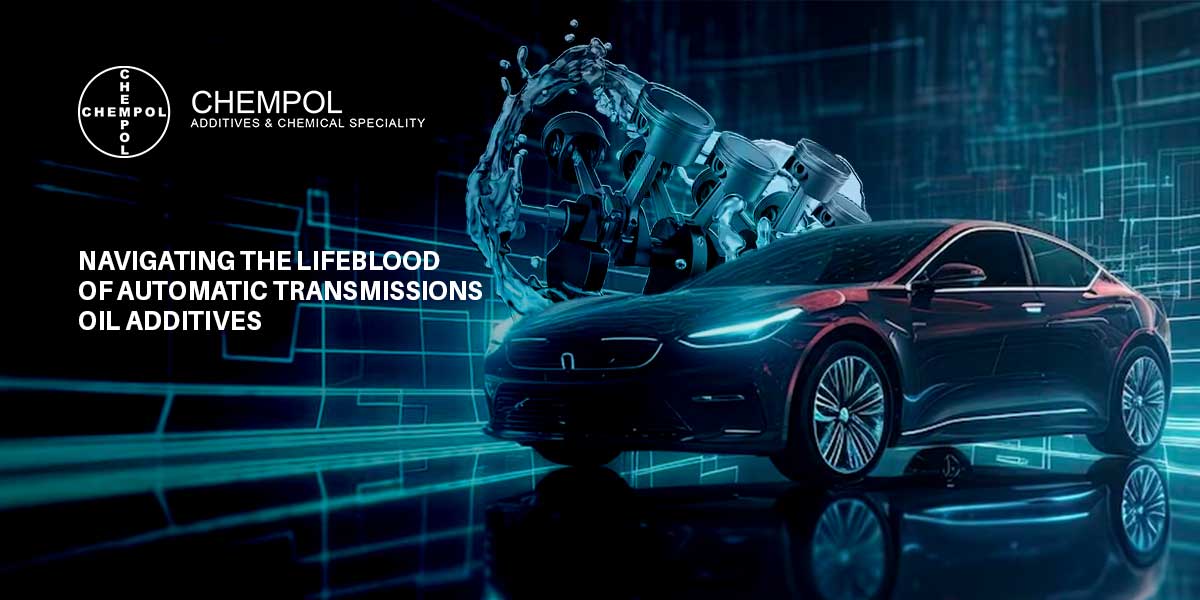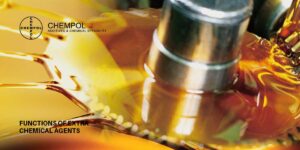
Navigating the Lifeblood of Automatic Transmissions Oil Additives
Automatic transmission fluids (ATFs) are the lifeblood of your vehicle’s transmission system, ensuring smooth gear shifts, reliable cooling, and optimal performance. Within these vital fluids, a relation of additives play a crucial role. At Chempol, we give it to detailed research and with the latest technology to come at pace with the modern lubricants to understand how these additives can protect and enhance the complex movement of gears within your vehicle.
The Core Functions of ATFs
ATFs are more than just lubricants; they are multi-functional fluids tasked with a Herculean role.
They lubricate to reduce wear, cool to prevent overheating and deliver the hydraulic pressure necessary for the transmission to function. But what makes ATFs unique is their ability to maintain these functions across a range of operating conditions — a task made possible by the meticulously engineered additives they contain.
Extreme-Pressure Agents
The demanding environment of automatic transmissions, where high loads and temperatures are commonplace, requires robust additives. Extreme-pressure (EP) agents rise to this challenge, safeguarding the metal surfaces within the transmission by forming protective layers that prevent metal-to-metal contact and reduce wear — even when traditional hydrodynamic lubrication gives way to boundary conditions under extreme stress.
Dispersants and Homogeneous Dispersions Create Harmony
A key to additive effectiveness is uniform dispersion within the ATF. Dispersants ensure that additives like alkali metal borates, traditionally known for their EP qualities, remain evenly distributed, preventing the formation of harmful deposits. At Chempol, we use advanced dispersants, such as alkyl succinimides, to maintain the clarity and efficacy of our ATFs.
Smooth Operators: Anti-Sticking Agents
To achieve the smooth gear shifts drivers expect from their automatic transmissions, anti-sticking agents are added to ATFs. These chemical compounds, including phosphates and carbamates, prevent adhesion that can disrupt gear synchronization and shift quality, ensuring a seamless driving experience.
Innovations in ATF Additives
The foundational principle of ATF technology is innovation. In order to meet the dynamic demands of contemporary hydrostatic transmission oil additives, our research and integration of the latest advancements in additive technology are ongoing. By extending the life of the transmission in your vehicle, our cutting-edge formulations offer superior protection and performance compared to comparable products.
Functions of Extra Chemical Agents Include the Following:
When it comes to the complex field of automotive engineering, the transmission is a wonder of precision and synchronization.
Its smooth functioning is ensured by a number of different anti-sticking chemicals, each of which plays an important part in supplying the additional lubrication that is required for maximum performance. Among these, phosphates, phosphates, phosphonates, thiophosphates, carbamates, molybdenum dithiocarbamates, and dithiophosphates stand out due to the distinctive qualities and essential tasks that they possess.
Phosphates
A highly recognized advantage of phosphates is their remarkable capacity to inhibit corrosion and attrition. These compounds endure a reaction with metal surfaces, which results in the formation of a protective coating that impedes friction and wear, even when exposed to high loads and temperatures. This coating is critical for averting metal-to-metal contact, which can lead to premature deterioration and failure.
Although phosphates serve a similar function, they offer an additional advantage. The high antioxidant properties of the lubricant contribute to its synergistic effect with other additives, thereby enhancing its oxidative stability. As a consequence of this, the gear lubricants retain their protective characteristics for extended durations, notwithstanding exposure to elevated temperatures and pressures.
Phosphonates
The thermal stability of phosphonates sets them apart; they also effectively inhibit the development of varnish and sediment. This practice guarantees the preservation of transmission component cleanliness, an essential factor in sustaining the gearboxes’ functionality and durability.
Thiophosphates provide an additional barrier, particularly in the face of exceedingly high pressures. Their capacity to endure substantial loads renders them well-suited for heavy-duty applications characterized by a substantially elevated risk of deterioration.
Carbamates
Carbamates are classified as multifunctional additives due to their ability to inhibit corrosion, abrasion, and oxidation. Due to their exceptional adaptability, these fluids are highly suitable for an extensive array of automotive applications, guaranteeing the optimal performance of the gearbox fluid throughout a broad spectrum of operational circumstances.
Molybdenum
The ability of molybdenum dithiocarbamates to form a long-lasting lubricating film on metal surfaces is unparalleled. The film possesses a notable capacity to endure elevated pressures and a broad spectrum of temperatures, thereby offering outstanding resistance to deterioration.
In conclusion, dithiophosphates are primarily recognized for their anti-wear and antioxidant properties. A sacrificial layer is formed when they react with metal surfaces; this layer plays a critical role in safeguarding gearboxes against the extreme friction encountered in an automotive gearbox.
When combined, these anti-sticking agents constitute a robust barrier against stickiness for contemporary automotive transmissions. Through friction reduction, wear prevention, and corrosion prevention, these components guarantee the transmission’s optimal operation, thereby instilling in drivers the anticipation of a seamless experience. In the highly competitive automotive lubricant market, the intricate chemistry of these transmission fluid additives is not merely an advantageous feature; rather, it is an essential component that establishes the standard of excellence for the end product. Chempol, through its steadfast dedication to innovation and exceptional quality, maintains a leading position in this field by providing cutting-edge solutions that establish a new benchmark for transmission fluid performance.
ATFs govern an intricate realm characterized by perpetual innovation and scientific progress. The additives contained in these fluids are crucial for ensuring the seamless, dependable, and efficient operation of your vehicle’s transmission. Chempol is dedicated to being at the forefront of ATF technology by delivering products that establish a benchmark for excellence in both quality and performance.
Chempol additives solutions:
Discover the difference that Chempol’s advanced ATF formulations can make for your transmission oil additives.
CHEMPOL 4146 Automotive Transmission Fluid Additive
CHEMPOL introduces its 4146 Automotive Transmission Fluid Additive for those seeking optimal functionality — a specialized solution designed to enhance ATF applications. Recommended at a 13% weight concentration, this additive is blended with suitable low-viscosity base stocks, ensuring the fluid meets the stringent viscometric and performance standards required for modern transmissions.
Chempol 4146 is not just another additive; it is an innovation that brings the rigorous specifications of DEXRON III and MERCON to a new level. It enables oils to achieve Brookfield viscosity values up to 20,000 centipoise at a chilling -40°C, ensuring reliable performance even under the most extreme cold weather conditions. This means that vehicles equipped with ATF containing Chempol 4146 can operate smoothly in cold climates, where the fluidity of the transmission oil is critical for starting and operation.
Moreover, Chempol 4146 is engineered to meet and exceed the performance requirements of various heavy-duty equipment manufacturers. Notable specifications such as Allison C-4, Caterpillar TO-2, and Hagglunds Denison HF-0 are within its capability. This versatility ensures that a wide array of machinery, from trucks to construction equipment, can benefit from the advanced protection and efficiency that Chempol 4146 offers. It is a testament to Chempol’s commitment to providing high-quality solutions that push the boundaries of lubricant technology.
CHEMPOL 4204 Automatic Transmission Fluid Additive
This additive is expertly formulated to blend at a concentration of 1.02% by weight with low viscosity base stocks, enhancing ATF to meet critical viscometric profiles and performance benchmarks required in today’s demanding applications.
Chempol 4204 is designed to optimize ATF performance, aligning with specifications once satisfied by DEXRON IID and MERCON standards. Its remarkable efficacy is demonstrated by its ability to maintain Brookfield viscosities as high as 50,000 centipoise even at the frigid temperature of -40°C. This characteristic is particularly advantageous for vehicles operating in cold climates, where maintaining the fluidity of ATF is essential for smooth engine starts and dependable transmission function.
This additive also meets the rigorous performance standards set by industry giants, ensuring compatibility with a range of equipment. Whether it’s for the Allison C-4, Caterpillar TO-2, or Hagglunds Denison HF-0 specifications, Chempol 4204 stands up to the challenge, offering unparalleled performance. The use of Chempol 4204 signifies an unwavering commitment to quality and performance, ensuring that vehicles and machinery operate at their peak, regardless of extreme temperature conditions.
CHEMPOL 4343 Gear Oil Additive
CHEMPOL 4343 stands as a testament to the innovation in gear oil additives, crafted for those who demand nothing less than premium quality for their automotive gear oils. This non-chlorine, extreme-pressure additive system is engineered to enhance the performance of gear oils beyond the ordinary.
When used at the recommended treat rate of 4.2% by weight in suitable base stocks, CHEMPOL 4343 elevates gear lubricants to meet the rigorous API GL-5 service classifications. This classification is indicative of lubricants capable of handling the high-pressure conditions found in automotive hypoid differentials and other applications where gears undergo significant stress, ensuring optimal protection and longevity.
For applications requiring a more moderate performance level, CHEMPOL 4343 proves its versatility. At a lower treat rate of 2.1% by weight, it adeptly produces gear lubricants that comply with the API GL-4 service classification. This makes it suitable for lubricants used in spiral bevel and worm gear axles, as well as in manual transmissions operating under milder conditions.
Incorporating CHEMPOL 4343 into gear oil formulations means investing in a product that delivers flexibility and performance. Whether for high-load, high-stress environments, or for less demanding applications, CHEMPOL 4343 provides the reliability and quality that automotive professionals and enthusiasts expect from a leading additive.
Contact us today to explore our products and find the perfect solution for your transmission needs.





